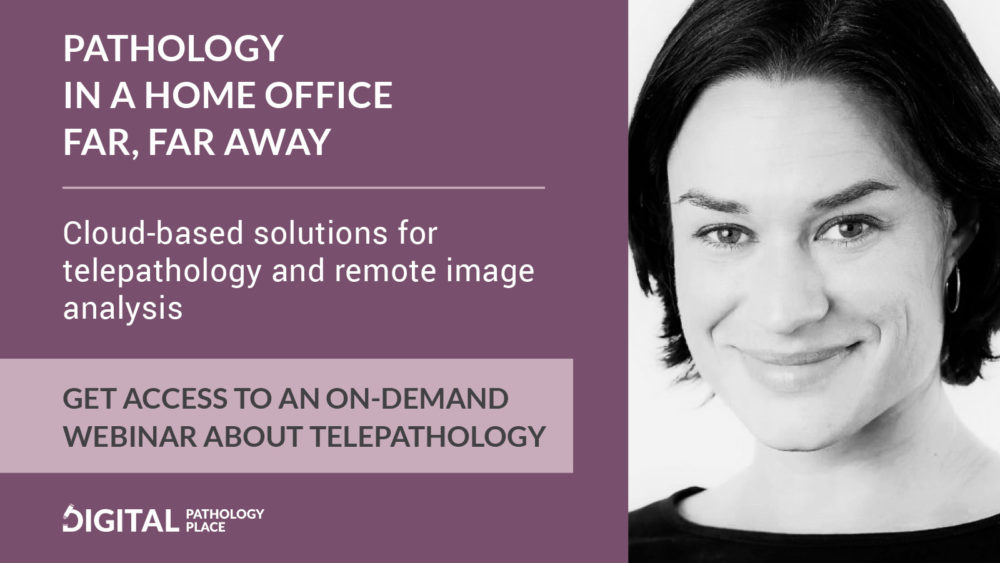As with so many other professionals, pathologists have been instructed to work from home during the time of the coronavirus pandemic. Even those who were hesitant before in one way or another are being pushed towards some form of telepathology.
Before the pandemic one would consider using a telepathology system:
- in remote areas, with no access to pathologists, such as northern Norway and Canada as well as many African countries
- for immediate frozen section evaluation when no pathologist was on site
- for educational purposes
- for proficiency testing in laboratories
- for second opinion consultations and tumor boards
- and far less frequently for primary diagnosis (especially in the US)
Now, with the necessity of remote work for the past three months, the adoption of this technology grew exponentially.
In this post you will learn about:
- What telepathology is,
- What are the most important telepathology milestones since its creation (and download them as PDF)
- How telepathology affects toxicologic pathology and
- Get access to an on-demand webinar about telepathology
To watch the webinar recording subscribe here
What is telepathology?
The broadest definition of telepathology is “the practice of pathology at a distance, often with use of telecommunication technologies”. The modern telecommunication technologies, such as digital whole slide image (WSI) transfer via the internet are incorporated in most of the current digital pathology applications, but also other, less mainstream methods, such as using a microscope camera over Skype or snapping pictures with your cell phone to consult with colleagues and tech students via WhatsApp fall into this category. They are used frequently all over the world. Nowadays with easy access to internet and digital cameras we really can get creative, but how was telepathology conducted in the “old” days? And what exactly triggered the development of this technology?
The origins of telepathology – how did it all start?
As simple and unspectacular as it sounds, telepathology was born out of the need for quick remote consultation, but it was not a simple consultation between colleagues.
It is not a secret that pathologists often disagree regarding diagnoses. Pathology is not an exact science and the diagnosed diseases often do not have sharp boundaries either. Therefore, there are tumor boards, pathology working groups and other pathology committees aiming to help reach a consensus in difficult cases. However, as common as those disagreements are, it is always a problem when patients’ lives are affected by them.
This was the case during the bladder cancer clinical trials of the National Bladder Cancer Project run in the 1980’s. The discrepancies between the institutions recruiting patients for the clinical trials and the central reviewing laboratory of the project were so significant, that they resulted in changing the patients’ treatment regimen. It would not be a problem if this would happen before the treatment started, but because there was a big lag between the original diagnosis and the central review, the patients were already being treated according to the often incorrect original diagnoses and had to change medications in the middle of treatment. This obviously made the clinical trial data impossible to interpret. It caused a real crisis in the National Bladder Cancer Project, and it sparked the development of the first telepathology system. The review of the diagnosis absolutely had to happen in real-time!
Dr. Ronald Weinstein was the director of the National Bladder Cancer Project central laboratory and was involved in reviewing the discrepant diagnoses. As an innovator and a serial entrepreneur, he was tasked with developing a system that would enable a centralized review of the diagnosis before the patients were enrolled in the trial. In 1985 together with his sister, he co-founded Corabi International Telemetrics, Inc, in 1986 brought to life the first analog dynamic-robotic microscopy system for remote diagnosis and used and introduced to pathology the term “telepathology” for the first time.
The system was sending images from a microscope located in one place to a TV monitor located in a different place via a bi-directional microwave telecommunications system and enabled the remote observer to steer the microscope stage in the original location.
Fast-forward 34 years and we all can have telepathology on our smartphones in our pockets…
Telepathology milestones

From the beginning of telepathology until the recent Centers for Medicaid and Medicare Services (CMS) memorandum allowing for remote case sign off from non-CLIA certified locations in the time of this COVID19 pandemic a lot has happened. The technology evolved rapidly, and the regulatory landscape changed just as fast.
1986
- Telepathology is born! Dr. Weinstein introduces the term “Telepathology” to the English language and officially launches the first analog robotic-dynamic telepathology system.
1988
- Following the “Pap Mill” scandal Clinical Laboratory Improvement Amendments (CLIA) ‘88 mandates a limit of 100 evaluated smears/day/cytotechnologist and requires proficiency testing of cytotechnologists and sign off from a CLIA certified location. “Pap mills” were laboratories analyzing too many slides per day often resulting in compromised quality of the evaluation and “false negative” results. False-negative results would state “no cancer” in cases where cancer was present. This was frightening both to patients and doctors, hence the changes mandated by CLIA in 1988. This practically banned a remote sign off. Pathologists could apply for CLIA certification for their home offices, but the administrative burden was high and very few did.
1989
- Telepathology gains a real-life use case in northern Norway. A network is established to provide frozen section service to five remote hospitals.
1994
- Commercialization proceeds – hardware for a complete dynamic-robotic telepathology system becomes available for purchase.
1995
- Armed Forces Institute of Pathology (AFIP) starts a telepathology consult service based on static images.
1999
- Thirteen years after the discipline was born, The American Telemedicine Association publishes the first guidelines for telepathology.
2000
- Technology advances. Whole slide imaging (WSI) and whole slide scanners enter the market.
- With the introduction of WSI scanners validation efforts of clinical digital pathology applications start.
2001
- US Army Telemedicine Program starts using dynamic telepathology.
2003
- Glass slide digitization with whole slide scanners enables computer-based image analysis on these files. This leads to the development of algorithms performing quantitative image analysis, their release as medical devices, and first FDA clearance for quantitative image analysis of IHC (ER- Cell Analysis & Her2 – Clarient).
2005
- US Army converts to a WSI platform
2009
- Digital Pathology Association is formed
2011
- A telepathology network is established in Eastern Quebec, Canada
2013
- The Royal College of Pathologists in Great Britain establishes official telepathology guidelines.
2014
- Idexx becomes the first veterinary diagnostic laboratory to go digital and provide remote veterinary pathology diagnoses.
- The Canadian Association of Pathologists establishes telepathology guidelines, American Telepathology Association updates the guidelines from 1999.
2017
- FDA approves of WSI for primary diagnosis in surgical pathology with the Philips IntelliSite system approved as a Class II medical device.
2019
- FDA grants Leica Biosystems 510(k) clearance for Aperio AT2 DX system.
2020, March 26
- Centers for Medicaid and Medicare Services (CMS) issue a memorandum with enforcement discretion to ensure pathologists may review pathology slides remotely during the COVID19 pandemic in non-CLIA certified locations if certain defined conditions are met.
2020, April
- FDA issues an Enforcement Policy for Remote Digital Pathology Devices during the COVID19 pandemic, which allows the use of different digital pathology hardware and software, even if they are not approved as medical devices. Before use, an internal validation needs to be performed at the institution where the devices will be used.
Telepathology and toxicologic pathology
The preclinical area of toxicologic pathology is operating within the Good Laboratory Practice (GLP) regulatory framework. It does not preclude veterinary pathologists from taking their microscopes and slides to their home offices and continuing their work on the primary review of their studies, and this is exactly what happened during the current pandemic. However, another part of the toxicopathologic workflow – the peer review, where the slides already reviewed and diagnosed by the study pathologist need to be reviewed again by another pathologist posed a bigger challenge as it was often connected with travel. The peer review pathologist travels to the primary review location to review the slides and discuss the findings with the primary review pathologist. As international travel bans were implemented across the globe, this halted abruptly. One solution to the problem was to ship the slides to the peer review pathologist instead, but this was connected with increased work for the laboratory personnel of packing and unpacking thousands of slides (yes, these are the numbers in a toxicopathologic study…) in addition to other shipment related activities, costs and time.
The obvious solution to the problem was to start using digitized slides and digital pathology systems to accelerate the process and the pharma industry quickly pivoted in that direction. The slides were scanned and transferred to the peer review pathologist digitally and the peer reviews could take place as scheduled causing only minimal changes in the laboratory workflow. As more and more toxicopathologists are interested in “tele-peer review”, efforts are made to make it as efficient as possible as well as expand this capacity to the primary review of GLP compliant studies.
Conclusion
The term telepathology, referring to practicing pathology at a distance, was first used in 1986. Since then a lot has happened in this discipline including going from analog to digital systems and telepathology’s “merger” with the discipline of digital pathology. Currently, during the COVID19 pandemic due to fast CMS and FDA response and loosening up the regulations pathologists can use various not yet FDA approved digital pathology hardware and software and are allowed to sign off remotely, which, although only temporary, is a huge regulatory leap. Toxicologic pathologists started using digital pathology platforms for peer review and validation efforts are planned for expanding the application to primary review in compliance with the GLP regulations.
The detailed list of the most important historical and regulatory milestones can be downloaded after signup:
If you would like to see an on-demand webinar about telepathology click below:
To watch the webinar recording subscribe here
Cloud-based solutions for telepathology and remote image analysis
In this webinar, a brief history of telepathology and its preclinical and clinical applications will be discussed followed by solutions for remote work and collaboration in pathology (from AI model generation to validation, data sharing, and remote teaching) as well as an overview of Aiforia’s cloud-based offering.
Presenters:
Aleksandra Zuraw DVM, PhD, Dipl. ACVP, Publisher at the Digital Pathology Place
Thomas Westerling-Bui PhD, Scientific Director from Aiforia















Comments are closed.